OLDER NEWS (3)
OFF THE BIKE: SAKURA IN HIMEJI
Even we will admit that sometimes it’s good to get off the bike and explore the area. No better time than the big Cherry Blossom Festival in Himeji. See our special report here.
LONG RIDE / HILL CLIMB 2015
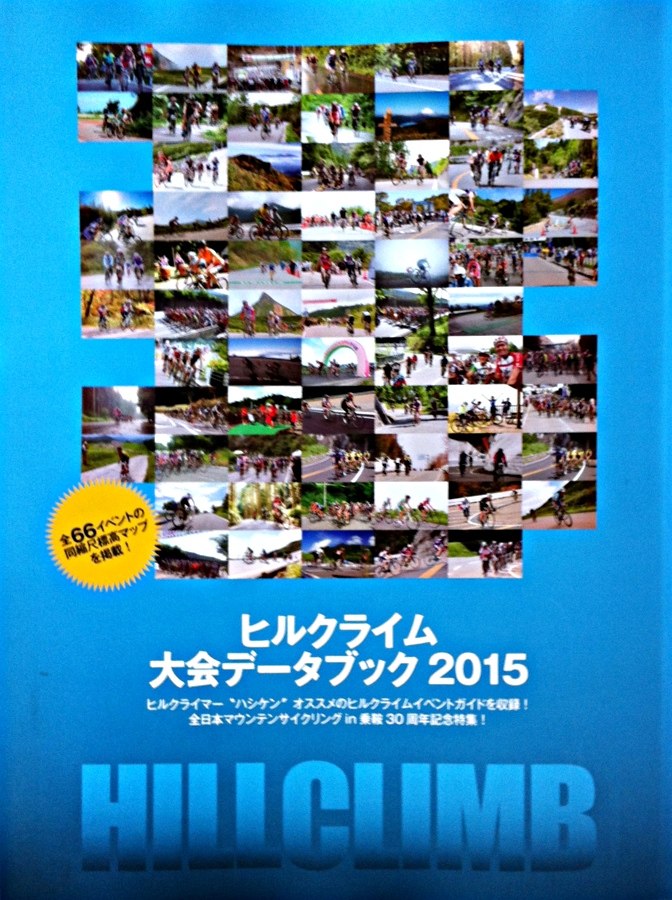

VACATION TIME
Too cold to do much cycling in Japan, so it’s a good time to go to warmer places. Here’s the view from the Tantalus lookout in Honolulu. This will soon be featured as the first “guest route” on the KANcycling site.

WINTER COLORS
Since it’s been so bitterly cold lately, it’s surprising that there’s such a disparity in landscapes. In the Japan Alps and up on the Japan Sea, it’s already winter wonderland, and some small villages have been isolated for days due to heavy snows. Meanwhile, down here in the Kansai, you can still see fall colors, even with less than a week to go before Christmas.
JAPAN ALPS BUS UPDATE
We reported this last year, but now have direct confirmation: Nohi Bus will take you and your bagged bicycle between Takayama in the Japan Alps and Kyoto or Osaka (and, presumably, Tokyo as well). Yesterday they didn’t even glance my way as I loaded my bike into and out of the luggage compartment. Caution is required, however, since some of the buses shown on the Nohi Bus site are run by other companies. Nohi Bus lists three buses daily between Kansai and Takayama (http://www.nouhibus.co.jp/new/takayama_bc.html), but a closer look reveals that one of the three going in each direction (the first bus Takayama -> Kansai and the last bus Kansai -> Takayama) is actually operated by Kintetsu Bus. Since Kintetsu and Hankyu are the two major nationwide bus companies that absolutely refuse to carry even bagged bicycles, there’s a strong likelihood that they would refuse to take your bike. So I’d recommend avoiding those particular time slots.
The buses linking Takayama with Shinjuku (Tokyo) are run about half-half by Nohi Bus and Keio Bus, which does allow bagged bicycles under certain conditions. Since the website is unclear, I confirmed directly with the Keio Kosoku Bus Center (03-5376-2222) that they DO take bicycles on board (in the luggage carrier below) as long as the bike is in a bike bag and as long as it’s not an overnight bus (on which bikes are not allowed).
Also note:
The price for Kansai has risen to 4700 yen one way (due to the consumption tax increase to 8%). The price for Shinjuku is 6690 yen.
Expect some delay in arriving if you’re traveling during weekend traffic or holiday periods. For what it’s worth, I took the Kansai-bound bus on a Wednesday and we arrived 20 minutes late due to road construction.
“HAGEMASHI NO SAKA”

The hill is not long, but it gets VERY steep at the end —though there’s some disagreement as to how long and how steep. This program said the hill is 600m long and the last 60m is a 13.5% grade. The Ohayo Nippon program says 900 m long (starting from a place further down?) and maximum grade of 22%. The Otaru city website says 904m and 24% grade. Whichever is correct, it appears to have become a popular cyclist destination in recent years due to a certain inn near the top —not named in the program, but appears to be Tomaya (3000 yen per night w/no meals - HP http://www18.ocn.ne.jp/~tomaya/index.html). For the past six years, with the encouragement of the family operating the inn, young people in particular have come from all over Japan to try to cycle up to the top. The rule is that you must cycle all the way to the top without resting and without your feet even touching the ground until the very end.
I haven’t done this since I didn’t know about it last summer when I was in Hokkaido. But it’s certainly something cyclists should probably put on the list of things to do in Otaru.
There appears to be no information on “Hagemashi no Saka” in English. There are some photos of it here:
http://8tagarasu.cocolog-nifty.com/sakamitisannpo/2006/08/2_f904.html
Your best bet is either to ask at the inn or get the city tourist people to point it out on the map to you. And, obviously, you’ll only be able to cycle it in the warm months.
As of this writing, Youtube links to the NHK Nippon Kiko program split into two parts (in Japanese, no subtitles) are here:
(Part 1) http://www.youtube.com/watch?v=_V7S2ADECYQ
(Part 2) http://www.youtube.com/watch?v=qzxnws1ZtmQ
As far as I know, NHK doesn’t normally allow its programs to be youtube-d, so I’d advise viewing these sooner rather than later.
The transcript (in Japanese) for the earlier Ohayo Nippon program is here:
http://www.nhk.or.jp/ohayou/marugoto/2013/08/0823.html
CYCLING KITAGISHIMA
Many, many lovely photographs illustrate this splendid article about cycling around one of the many small islands in the Inland Sea. Written by Japan Times columnist Amy Chavez, who also coordinates reservations for the wonderful Shiraishi International Villa on neighboring Shiraishi.
RINKO FOR DUMMIES

MAPLE YABA UPDATE (May 2014)
Last year we reported on the damage to the Maple Yaba Cycling Road in Kyushu due to torrential rains. A note on the Nakatsu City page for the cycling road says that the section of the route between the Yabakei Cycling Terminal and Morizane, Yamakuni-machi became passable as of April 1, 2014, and the entire route is expected to be back by the end of May of this year. Even better: the lovely bridges look to still be there in some form (a photo shows the stone bridge piers intact ). See the article (in Japanese)
http://www.city-nakatsu.jp/kankou/kankouti/2011080800334/
(A photo of one of the bridges being repaired can be seen at http://www.nishinippon.co.jp/nnp/oita/article/82390 .)
LONG RIDE HILL CLIMB
If it’s May, it must be time for Cycle Sports Magazine’s “Long Ride / Hill Climb” supplement listing all of the events for the coming year.
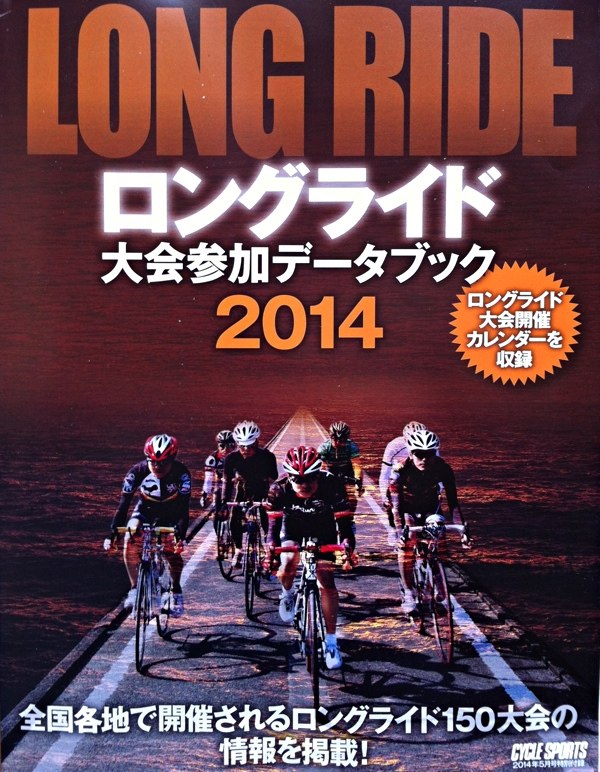

This year’s version is actually tilted slightly more heavily to LR (59p) than HC (41p), but each has its own lovely cover, and the first few pages of each end (with some of the best photos) are in color. As always, it is absolutely FREE with purchase of the magazine (now 823 yen instead of 800 due to the increase of the consumption tax from 5% to 8% starting April 1). The issue went on sale a couple of days ago and should be available for a month, but I recommend buying your copy sooner rather than later.
LIFE IS COMING UP CHERRIES!
Well, blossoms at least. Nice warm cycling weather, here at last.

HAPPY NEW YEAR!
From KANcycling, best wishes for great rides in 2014!
MAGAZINE WATCH
Cycle Sports magazine is your main source for annual cycling events booklets — they issue one for hill climbs / long rides AND have put out two booklets with reader-suggested routes in recent years. But you should watch the other magazines as well, since they can sometimes surprise you. Here’s an example: this year the June issue of FunRide Magazine includes a hill climb insert (shown down at the very bottom of the cover):

Not sure they’ve ever done this before. Here’s a closeup:

This year seems to be one in which the magazines include a lot of other freebies (caps, etc.) so maybe not so many route guides. We’ll keep watching.
LONG RIDES & HILLS 2013
So the question this spring, as every spring, was: will the April 2013 edition of Cycle Sports Magazine continue their tradition (recently revived) of offering a big fancy booklet listing all of the big cycle events for the coming year?
... and the answer is... no.
But don’t despair. This year it’s the MAY edition of Cycle Sports Magazine that has it:
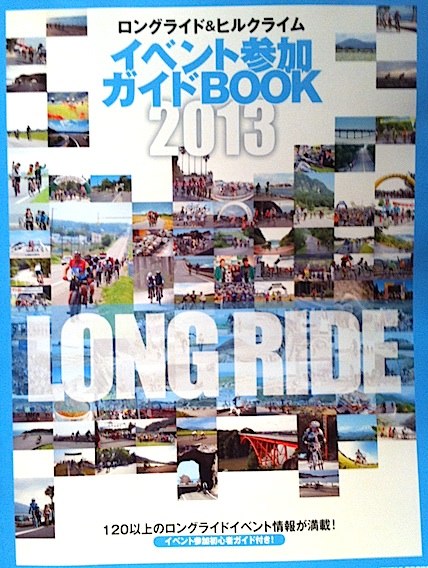

Next year: maybe June, or April, or some month in the Mayan calendar. Who knows. At least it’s here again this year, all 100 pages of it, with the same twin covers giving equal billing to Long Rides and Hill Climbs, the same extensive coverage, and the same huge maps of Japan for both LongRides and HillClimbs showing events nationwide for the entire year. And, best of all, the booklet is still FREE with your purchase of the 800 yen magazine. Get them before they’re all gone.
MAPLE YABA UPDATE
[UPDATE: The Maple Yaba Cycling Road has since been restored.]
Reader RS writes with an update on the Maple Yaba Cycling Road in Kyushu (12/2013):
“Having read the advice from a fellow rider on your homepage about the condition of the route following the typhoon this summer I was quite surprised at what I found when I got there. The cycling road is in VERY bad condition with extensive damage and many parts totally destroyed and unrideable (particularly around the Yabakei area). One of the bridges (often photographed) has been washed away and therefore an extensive diversion is required back onto route 212 there, but other areas were also in poor condition with barriers broken, bent over or totally washed away. Lots of the bridges also have lots of debris 5-6meters up from the river, and in some places the asphalt has been washed away or has collapsed to the point that cycling over it would be impossible. A local man I spoke to said that it'll take 3 years to get everything back to normal - I would absolutely agree with that and maybe even add on a couple more years as well, which is such a shame as today especially, with the autumn colors, the scenery in that area is beautiful.”
CHECK THE FINE PRINT
Just a reminder that you should check carefully when making bus reservations to make sure the bus company isn’t one that refuses to carry bicycles. Example: the Matsumoto - Kansai highway bus route is served by two companies, Alpico and Hankyu. Alpico is fine with bagged bicycles on anything but overnight buses, but Hankyu refuses to carry bagged bikes under any circumstances. Be sure to check carefully so you don’t get a nasty surprise at the bus stop - if the driver refuses to allow the bike on board, you’re left with the train, which doubles the price of your journey.
YABBA DABBA DON’T?
A reader writes to inform us that the Maple Yaba Cycling Road was hard hit by the typhoons this summer and “many sections will probably be closed for a year or two” - but that the ride is still worth doing, switching to the road as needed. Consider yourself forewarned (and apologies for the Flintstones’ reference in the title). The reader also provided a link to a YouTube video that, alas, seems to be blocked in Japan because Victor Entertainment apparently felt that the BGM was a copyright violation. Here’s the link:
http://www.youtube.com/watch?v=TuCGuSSg5DM
Take a look if you can get access. The cycling road appears to be clearly blocked in at least two locations, including a collapse at one of the lovely stone bridges. It would probably be prudent to try to find out which parts are accessible before you go.
[UPDATE: The Maple Yaba Cycling Road has since been restored.]
BEST ROADS TWO

Cycle Sports magazine’s “Best Roads” insert, in which readers submitted their favorite routes, was obviously a huge hit - because they’ve done it again in the September 2012 issue. It’s now larger in both size (A4) and length (82 pages). As before, the routes cover the entire country, and some pages are in color. And they seem to have put out the September issue earlier than usual so summer riders can use it. The insert comes absolutely FREE with your purchase of the 800 yen magazine. Obviously, highly recommended.
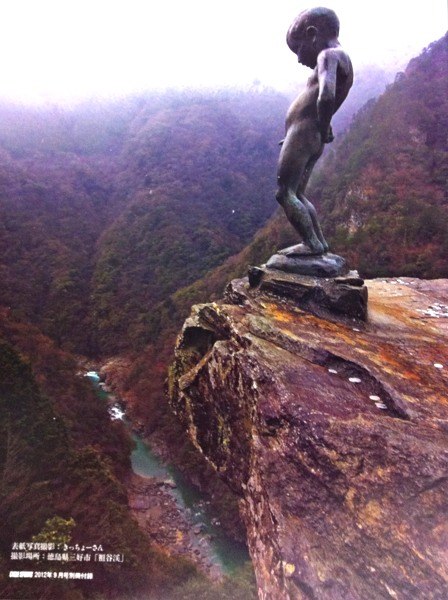
P. S. The back cover, shown here, is not Photoshopped - this statue actually exists in Shikoku’s Iya Valley.
AIRLINE UPDATE (updated)
Japan Airlines’ bagged bicycle policies are apparently unchanged, and if possible even better than ever. I flew to Hokkaido from Osaka’s Itami Airport a few days ago and, as before, had NO problems getting the bagged bike on board. They asked about aerosol cans (but not patch repair glue - yay!) and were mostly concerned about the safest way to lift and place the bicycle. As before, anything under 20 kg including a bagged bicycle travels FREE. And the process couldn’t possibly have been easier or more hassle-free. Wonderful.
[Update to the update to the update: Oh, well, somebody DID ask about patch glue when I left Sapporo’s Chitose Airport - rats. But the bike flew free and arrived in perfect condition on both flights, and that’s the important thing. At some point, we’ll work up a list of places where you can find patch glue near major airports - probably with the exception of Kansai, since you can’t cycle across the bridge to and from the airport anyway.
MAKE THAT LONG HOT SUMMER
When people are complaining about the heat even in Hokkaido, you know it’s HOT - and a more appropriate top page photo is definitely long overdue.
SUMMER
And only mid-June...
AND, ONCE AGAIN, NOT SO GOOD BUS NEWS
If you’re going to Hagi (on the Japan Sea coast), be aware that BOTH of the bus companies (Kintetsu Bus and Bocho Bus) that run long-distance buses in and out of Hagi absolutely refuse to carry bagged bikes - no exception. So if you’re trying to get in or out of Hagi, it’s the train or the road. Sigh. Fortunately, the best way in and out of Hagi is still the road through the Akiyoshidai plain, and the bikepath that leads from there directly to Yamaguchi. More on that route soon.
ONE OF THESE THINGS IS NOT LIKE THE OTHERS
This should be an easy test for readers of this site.
(Click photo to enlarge)
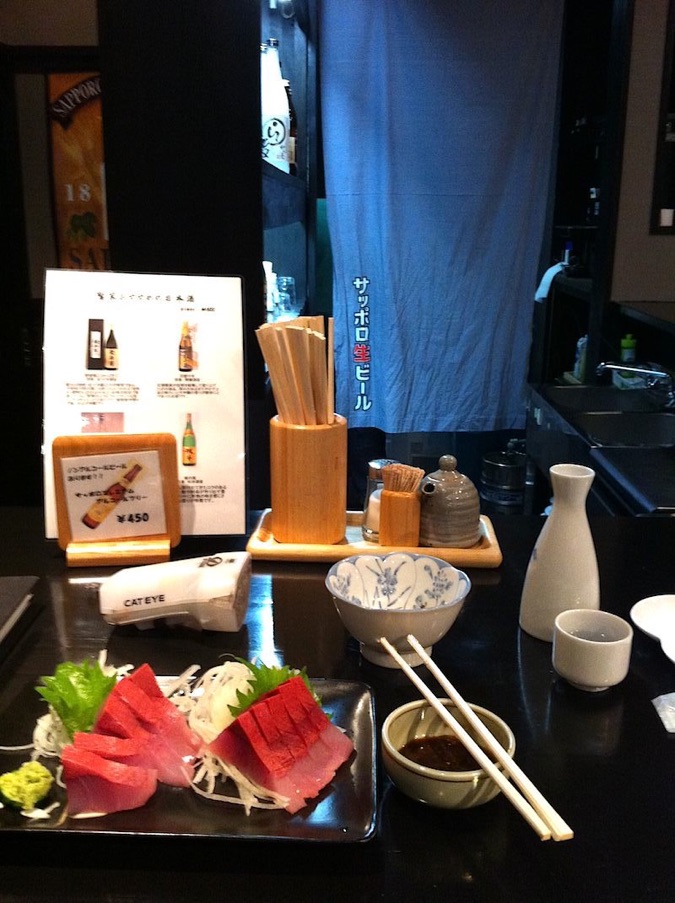
(Photo taken at a small restaurant in Hakuba)
SPRING AT LAST
After the longest stretch of pre-spring cold that I can remember, warmth arrived yesterday - one day too late for all of the Saturday cherry blossom events, including the big one at Himeji Castle. Oh, well.
BUS UPDATE
We note that Alpico, the company that runs a number of buses to and from the Japan Alps, states on its website that its luggage carrier below cannot accommodate “skis, snowboards, bicycles and other large luggage.” But they follow that up with a note in parentheses that this applies only to the overnight buses - meaning presumably that bikes are not a problem for the daytime buses. In the past, I haven’t had problems, and anyway I will be testing this hypothesis in the near future, so stay tuned.
LONG RIDES & HILLS
So since mid-March the question has been: would the April edition of Cycle Sports Magazine once again include the newly revived cycle events calendar, which last year became the Long Ride / Hill Climb booklet? We have our answer. Features maps of all of the routes, lots of photos, and a big map of Japan showing the locations of all LR/HC events. As a bonus, this year they finally put “Long Ride” on one of the two covers, given equal billing with hill climbs.


The booklet is FREE with your 800 yen purchase of the magazine. Get yours before they’re all gone.
MORE GOOD NEWS ON BUS-BIKE TRAVEL
For the second year in a row, I had no trouble getting my bicycle aboard a Chuo Kotsu Travel Club bus - the driver didn’t even blink when he saw me and the bagged bike. (They were using a double-decker bus that day, meaning more leeway for storage, too.) The upshot is that I was able to get myself, my bicycle and a huge bag of delicious souvenirs all the way from downtown Hida Takayama to Shin-Osaka Station for a still-astonishing 2900 yen. Needless to say, both Takayama and the Chuo Kotsu bus (http://www.chuo-kotsu.co.jp/tc/) are highly recommended; watch this site for a killer Takayama bicycle route in the near future.
BIKEBAG UPDATE
So here is the photographic proof that a large frame road bike will indeed fit in the tiny lightweight Tioga Cocoon (with the seatpost sticking out - it’s designed to carry a bike that way; you could always remove the seat):

(Later I’ll post another photo showing the rear wheel left on but the chain off so you can roll it.)
The bag also folds up to about the size of your palm. And did I mention how light it is? Lastly, the material does seem pretty tough.
Some caveats are in order:
- Since it’s a tight fit, it will probably take you longer to pack the bike - no more 3-minute rush jobs.
- More importantly, note that, if you carry it like this, the most fragile parts of the bike - forks, chainring and derailleur - are all on the bottom. So if you drop it, you’re sunk. (I’ll experiment to see if it can be carried more safely.)
The verdict: if I’m on a long trip and will be packing and repacking the bike — and ESPECIALLY if I’m entrusting it to baggage handlers on a bus or airplane — I think I’d want to take a regular bikebag, at least until I get used to this one and also figure out a way to protect the forks, chainring and derailleur.
But this bag is going in my bikepack permanently from now on (yes, it’s that light; use a lighter strap than the ones they’ve provided and you’ll never know it’s there). That way I’ll always have a solution if I suddenly need to take a train or bus home.
LITTLE BITTIE BIKEBAGS
For the past few years, it seemed that bikebags were getting larger and more expensive. But the popularity of tiny folding bikes seems to have pushed the market in the other direction. Tokyu Hands now offers two that are much, MUCH smaller than the traditional ones.
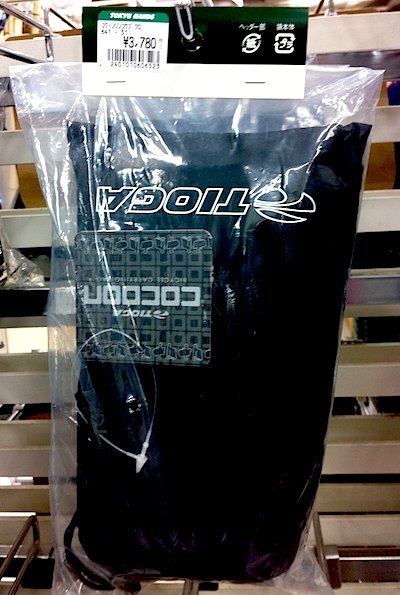
This model, the Tioga Cocoon, is quite a bit smaller than the smallest bags up to now, and a bit less expensive (3,780 yen). More importantly, being made of nylon, it’s light as a feather! (Not sure how well it will wear, though.) The other one, bearing the brand name Mont-Bell, is a bit heavier than that and quite a bit more expensive (6,800 yen), but it’s the most compact one I’ve ever seen:

(Update: The Tioga Cocoon will actually fold down to about this size too!)
I plan to buy the Tioga Cocoon in the near future to confirm that it actually fits a large road bicycle frame (the salesman said it did, but he didn’t know about the smaller bag), and to try to gauge whether the bag material will wear as well as the conventional bags. Stay tuned...
WARMER CLIMES
(WARMER CLIMBS)
If the roads are too frozen or the winds are too cold for you to justify January/February cycle journeys in Japan... well, there’s always the option of finding other places to travel. Below is a self-portrait (make that CellPh-portrait) taken at the Tantalus lookout that offers spectacular views of Honolulu including Diamond Head which you can see at upper right. It’s also a great ride; this will be KANcycling’s first Guest Route, so stay tuned.
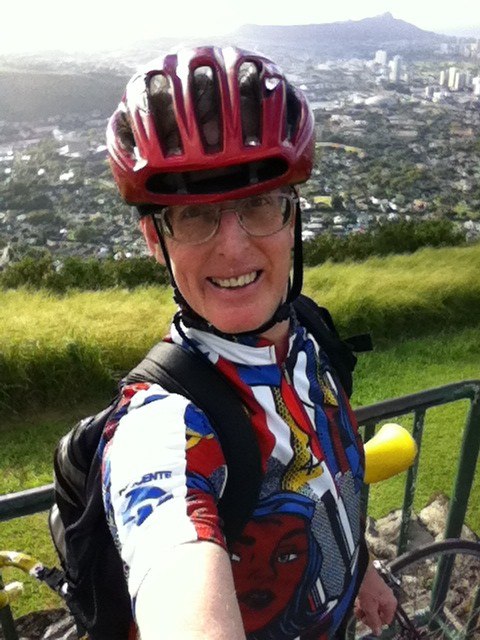
JAPAN ALPS BUS UPDATE
Bus access to the Japan Alps from Kansai continues to be fluid, with one disappointing change but also good news.
- Buses to/from Matsumoto remain the same: Hankyu does not accept bagged bicycles, Alpico does. Since the reservations are handled together, it’s not immediately apparent which company is running buses on which days (they alternate) so you should check the schedule carefully to make sure you’re not trying to travel on a Hankyu day.
- Sadly, Chuo Kotsu Travel Club changed its rules in August and no longer allows bicycles on board. For a long time, this was the cheapest way to get to/from Takayama, but they also raised their price to ¥3500 one way, making it slightly less of a great deal.
- The very good news: I was able to confirm directly with someone at the Nohi Bus Center in Takayama that Nohi Bus definitely DOES allow bagged bikes on their buses that run between Kyoto/Osaka and Takayama “as long as the bicycle is in a bag and not too huge.” The fare is slightly more expensive (¥4000 to Kyoto, ¥4500 to either Higashi-Umeda or Namba in Osaka) but that’s still only about half what a train would cost. See www.nouhibus.co.jp or www.j-bus.co.jp or call 0577-32-1688 or 06-6772-1631 for more information. (Note that Kintetsu also has buses to and from Takayama, but like Hankyu they refuse to allow even bagged bikes on board.)
Also keep in mind that both Matsumoto and Takayama bus routes are quirky in that you have to SHOW your ticket to get on the bus but you also have to GIVE the ticket to the driver when you get off at the end of the trip — so keep it safe and handy, and don’t lose it.
LSD FOR HEALTH
The cover of the latest issue of FunRide Magazine is a head-turner, and not just for the fetching young lass it features:

I was stopped by this headline:

Translation: :”Strengthen your trunk, heart and lungs with LSD!” Whaaaaaat?
Turns out LSD stands for “Long Slow Distance,” a training regimen that’s been around for quite awhile. There is a great deal of information about it on the web, so I may be just the last to hear about it. Anyway, more proof that you can learn something new every day if you pay attention.




































